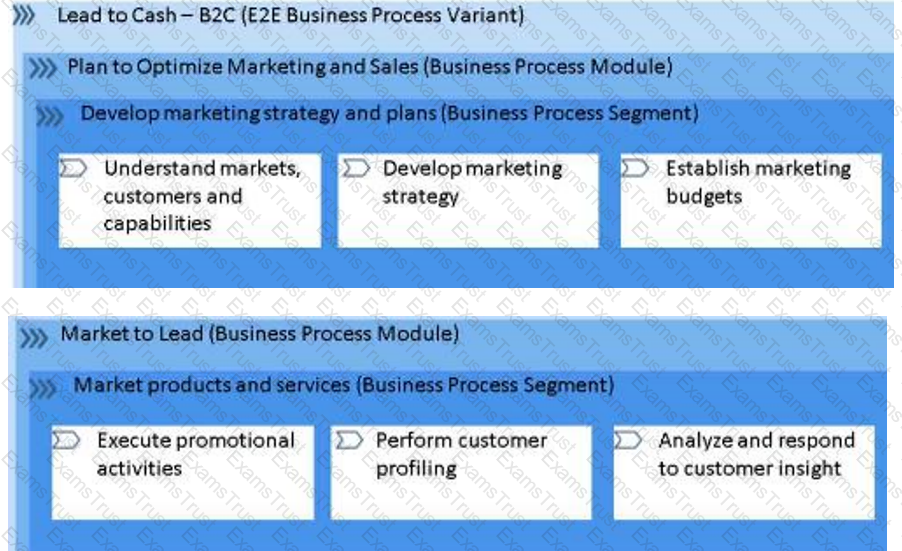Which of the following roles are missing from Wanderlust's current Enterprise Architecture practice structure? Note: There are 2 correct answers to this question.
As Chief Enterprise Architect of Wanderlust GmbH, you have just finished documenting the business ecosystem around online marketing. The CEO is asking for a suitable artifact to rejuvenate online marketing with a set of employees and partners. What would you do to be ready with the right information in this situation?
The CIO of Wanderlust strongly feels that the seldom-used legacy Marketing application cannot be the platform to rejuvenate their online marketing business. As Chief Enterprise Architect, the CIO has entrusted you with the responsibility of finding a suitable replacement that can support all current processes and also address the issues plaguing the existing application. Which of the following should you do to conclusively shortlist possible applications to replace the existing one? Note: There are 2 correct answers to this question.
As Chief Enterprise Architect, you are asked to select an Enterprise Architecture toolset for Wanderlust GmbH' Enterprise Architecture activities. What are the most critical selection criteria you should consider? Note: There are 3 correct answers to this question.
Tho Wanderlust CIO wants to focus loss on marketing strategy and planning, to instead prioritize marketing implement goals in mind to enhance number of leads generated:
• Run effective and highly visible campaigns (for example. on social media)
• Increase cross selling opportunities through online recommendation
AS the Chief Enterprise Architect Of Wanderlust. assisted by the SAP Enterprise Architects, you have been trying to re
goals with the Business Process Modules, Segments and Activities in the Lead to Cash B2C Business Process Varia Business Architecture content repository (see graphic below).
What are relevant combinations Of business activities and goals based on the graphic below?

Note: There are 2 correct answers to this question.
See the Image
While discussing the Smart Battery initiative in greater detail with the appropriate stakeholder, as Chief Enterprise Architect of Wanderlust, you discover that several key areas such as value proposition, cost structure, revenue streams, partners, and channels have been worked upon in isolation and therefore do not tally with each other. Which artifact would you recommend to bring all the above key dimensions together in a single window, to have a unified, consistent, holistic view of the Smart Battery initiative?
Wanderlust's numbers for order booking have been on a free-fall, ever since a recent economic downturn reduced showroom footfall to near zero. To counter the drop in in-person bookings, the CEO and CIO have been looking to revive their online channel, which was started six years ago. However, this channel was seldom used before the pandemic, which has led to a complete breakdown of Wanderlust's online marketing business ecosystem. Also of major concern, is their existing Non-SAP Marketing application, which lays unused due to poor integration with SAP CRM. As Chief Enterprise Architect, you have been approached by the CEO to document the online marketing business ecosystem first. Which of the following actions would you do to meet your CEO's request? Note: There are 2 correct answers to this question
As the Chief Enterprise Architect of your company you have been asked by the CIO to apply agile principles instead of following the sequential phases of TOGAFS ADM. How do you respond?
As Chief Enterprise Architect, you want to select an extension option that follows SAP's clean-core strategy. What are your recommendations to implement the clean-core strategy best?
Why would you recommend building SAP Side-by-Side Extensions to an S/4HANA system based on SAP BTP?
Green Elk & Company is the world's leading manufacturer of agricultural and forestry machinery. The former company slogan "Eik always runs has recently been changed to "Eik feeds the world" One of Green Elk's strategic goals is to increase its revenue in the emerging markets of China, India, and other parts of Asia by 80 % within three years. This requires a new business model that caters to significantly smaller farms with limited budgets You are the Chief Enterprise Architect and the decision was taken to implement regional S/4HANA productive systems while ensuring a high degree of standardization. Which of the following implementation approach would you consider best in this case?
What kind of applications can you develop with SAP Business Application Studio?
You design a Solution Architecture, based on SAP S/4HANA, for an internationally active customer that has a national subsidiary in China and other countries that have special requirements for data storage. As the responsible Enterprise Architect, your task is to propose a solution that takes these special requirements into account. How do you proceed when your customer's Architecture Guideline calls for following a "cloud-first" approach?
What are important factors of the SAP BTP. Cloud Foundry environment during runtime that you need to consider?